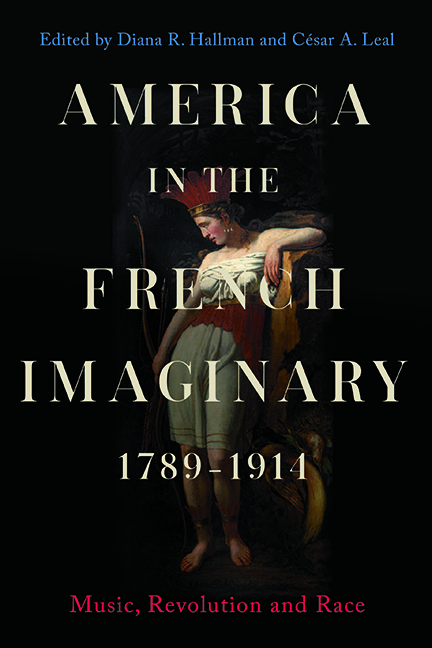Book contents
- Frontmatter
- Dedication
- Contents
- List of Illustrations
- List of Music Examples
- List of Abbreviations
- Editorial Notes
- List of Contributors
- Acknowledgements
- Preface
- Introduction
- Part I American liberté, sauvagerie and esclavage
- Part II Myths of America and Intersecting Identities
- Part III Soundscapes and Sonic Fantasies
- Part IV America, Commodification and Race at the fin de siècle
- Bibliography
- Index
- Music in Society and Culture
2 - Justamant’s Le Bossu and Depictions of Indigenous Americans in Nineteenth-Century French Ballet
Published online by Cambridge University Press: 15 September 2022
- Frontmatter
- Dedication
- Contents
- List of Illustrations
- List of Music Examples
- List of Abbreviations
- Editorial Notes
- List of Contributors
- Acknowledgements
- Preface
- Introduction
- Part I American liberté, sauvagerie and esclavage
- Part II Myths of America and Intersecting Identities
- Part III Soundscapes and Sonic Fantasies
- Part IV America, Commodification and Race at the fin de siècle
- Bibliography
- Index
- Music in Society and Culture
Summary
On Saturday evening 19 January 1867, a revival of the play Le Bossu opened at the Théâtre de la Porte-Saint-Martin with new ballet divertissements choreographed by Henri Justamant starring the dancer Mlle Mariquita. Le Bossu, an adaptation of Paul Féval's popular novel, was already well known to Parisian audiences, and the actors Mélingue, Vannoy, and Laurent all reprised their roles from the original 1862 production. The novelty of Justamant's ballets was therefore a key attraction: as Louis Ulbach wrote in Le Temps, ‘the new ballet will bring the crowds back, even those that already applauded Le Bossu’. Justamant created two new divertissements for the reprise: a series of lively ‘gypsy’ dances in the fourth tableau and an elaborate ‘Grand Ballet Indien’ in the eighth tableau, the latter of which featured Native American ‘prairie girls’ and ‘huntresses’ frolicking by the Mississippi River flowing pure gold. Ulbach's review proved prophetic: Mariquita's fiery performance of Justamant's choreography, especially in the exotic ‘Grand Ballet Indien’, came to be one of the most celebrated elements of the show, and Justamant's ‘Indian’ ballet entered the popular imagination, becoming one of the most significant portrayals of Indigenous Americans in nineteenth-century Parisian ballet.
This essay examines representations of Indigenous Americans in nineteenth-century French ballet, focusing on the ‘Grand Ballet Indien’ of Le Bossu as a case study. Although several scholars have written about depictions of Indigenous peoples in European music and dance, most have focused on written texts (libretti, press reviews), iconography (costume designs), and sound (musical scores). Few have studied movement. After all, any discussion of actual movement is difficult, if not impossible, given the ephemeral nature of dance as an embodied oral tradition. For Le Bossu, however, we have Justamant's manuscript staging manual with choreographic notations of his version of the ‘Grand Ballet Indien’ divertissement from the 1867 Porte-Saint-Martin revival. The notations have allowed us to reconstruct what these so-called ‘Indian’ dances would have looked like in late nineteenth-century Parisian ballet – or, at least, how they were envisioned by one of the leading choreographers of the day.
Justamant's distinctive notation system is remarkably clear and explicit, and can be read by any dance scholar well versed in the gestural language of nineteenth-century ballet, making his staging manuals a valuable – if still largely untapped – resource.
- Type
- Chapter
- Information
- America in the French Imaginary, 1789-1914Music, Revolution and Race, pp. 50 - 99Publisher: Boydell & BrewerPrint publication year: 2022



